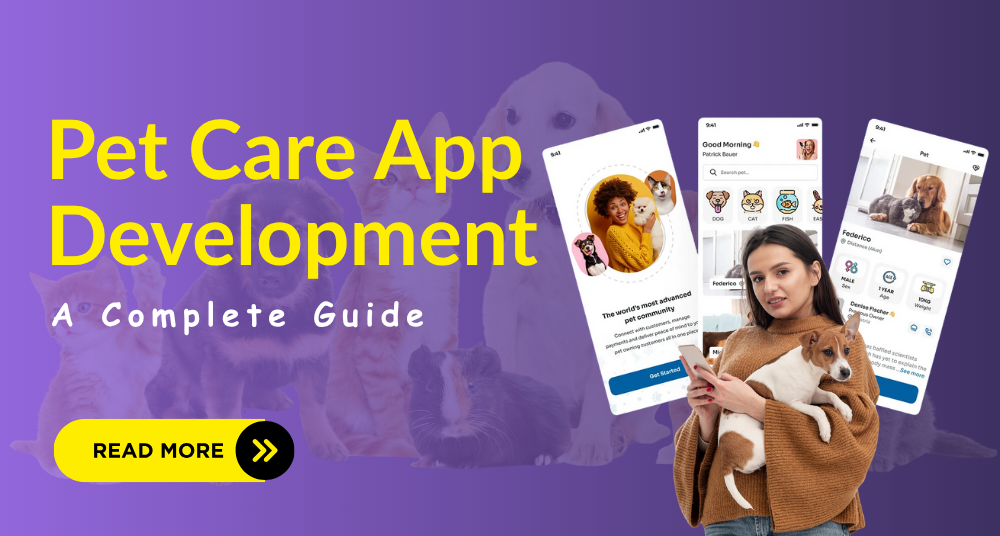Technology has changed how humans live, work, and interact — and now, it’s transforming how we care for our pets. In the modern digital world, pets are no longer just animals; they’re beloved family members who deserve comfort, attention, and care.
This emotional bond between humans and their pets has given rise to a booming pet care technology market, where mobile applications are helping pet owners monitor, feed, train, and even communicate with their furry companions remotely.
This guide explores everything you need to know about Pet Care App Development in 2025 — from market insights and essential features to monetization, cost, and future innovations.
The Rise of the Digital Pet Care Market
The global pet care industry has grown exponentially over the last decade. More than 50% of households worldwide own at least one pet, according to global reports. With this surge, there’s been an equal rise in spending on pet health, grooming, and comfort.
Technological advancements like AI, IoT, and cloud computing have further accelerated this growth, enabling pet owners to stay connected with their animals at all times.
Market Statistics:
- The global pet care app market is expected to surpass $20 billion by 2028, growing at a CAGR of 20%.
- The pet wearable market (trackers, collars, fitness monitors) is projected to reach $10 billion by 2027.
- Over 50% of pet owners in the USA use mobile apps for pet health, training, or nutrition management.
This shows that pet care app development isn’t just a trend — it’s a high-potential business opportunity.
Why Invest in Pet Care App Development?
Building a pet care app is more than a startup idea — it’s an emotional connection that solves real-life problems for pet owners.
Here’s why businesses are investing heavily in this niche:
- Rising Pet Ownership: Increasing number of pet parents worldwide.
- Shift Toward Premium Pet Care: Owners are willing to spend on quality services.
- Remote Monitoring Demand: People want real-time updates on their pets’ health and location.
- Expanding E-commerce Segment: Online pet food and accessories sales are booming.
- AI & IoT Integration: Smart collars and health trackers make pet care smarter and easier.
Simply put, pet care apps are creating a digital ecosystem that bridges the gap between owners, veterinarians, and service providers.
Types of Pet Care Mobile Apps
Before diving into development, you must identify what kind of app you want to build. Each type targets a specific need:
Pet Health & Wellness Apps
Track medical history, vaccination schedules, and vet appointments. Some even integrate wearable devices to monitor heart rate and sleep quality.
Pet Training Apps
Provide video tutorials, expert consultations, and progress tracking to help owners train their pets at home.
Pet Walking and GPS Tracker Apps
These apps use GPS and IoT sensors to track pet movements, walking routes, and activity levels in real-time.
Pet Grooming & Vet Booking Apps
Enable users to book grooming, spa, and veterinary appointments instantly via the app.
Pet eCommerce Apps
Exclusive platforms to shop pet products, food, and medicines online.
Pet Sitting or Adoption Apps
Connect pet owners with sitters, shelters, and adopters. These promote responsible pet ownership and community welfare.
Must-Have Features in a Pet Care App
A great pet care app focuses on usability, speed, and accuracy. Below are the most essential features to include:
Core Features for Pet Owners
- User Registration & Profiles: Create accounts and add pet details (age, breed, vaccination dates).
- Dashboard: A clean, informative interface with quick stats and updates.
- Health Records Storage: Store and access medical history anytime.
- Reminders: Set alerts for grooming, vet visits, or vaccinations.
- Activity Tracker: Monitor daily walks, calorie burn, and hydration.
- Diet & Nutrition Planner: Suggest meals based on breed, weight, and health.
- Vet Chat & Video Consultation: Connect instantly with licensed veterinarians.
- Emergency Locator: Nearby clinics, pet stores, or rescue centers.
- Push Notifications: Custom alerts for reminders or product offers.
Advanced Features
- IoT Device Integration: Connect with smart collars or fitness trackers.
- AI Recommendation Engine: Personalized health and diet tips.
- Social Sharing: Let users share pet milestones.
- Cloud Sync: Access pet data from any device.
- Multi-Pet Management: Add multiple pets under one profile.
Designing an Intuitive Pet App (UI/UX Best Practices)
User experience is everything in pet care apps. Pet owners prefer simple, playful, and colorful designs that reflect warmth and reliability.
Design Tips:
- Use pastel or earthy color palettes to create a calm, pet-friendly vibe.
- Add illustrations or icons representing dogs, cats, and other animals.
- Ensure smooth navigation with minimal clicks.
- Provide dark mode and voice control options.
- Make the onboarding process quick and guided.
A thoughtful design enhances emotional connection and boosts retention rates.
How AI and IoT Are Transforming Pet Care Apps
AI and IoT technologies are making apps smarter and more personalized.
AI Integration Examples
- Predict pet health issues using pattern recognition.
- Generate personalized diet plans.
- Chatbots that answer basic queries instantly.
- Facial recognition to identify lost pets.
IoT Integration Examples
- Smart collars that send real-time health data.
- GPS-enabled devices for live tracking.
- Smart feeders and litter boxes controlled through the app.
Together, AI + IoT ensures proactive pet care with minimal human intervention.
Monetization Models for Pet Care Apps
Monetizing a pet care app can be done in several ways:
- Freemium Model: Offer free basic features; charge for premium tools like vet chats or analytics.
- Subscription Plans: Monthly or yearly memberships for exclusive services.
- In-App Ads: Pet-friendly brands can advertise products.
- E-commerce Commissions: Earn revenue from product sales.
- Affiliate Marketing: Partner with pet stores and vets for cross-promotion.
- On-Demand Services: Charge for bookings like grooming or pet sitting.
Diversifying revenue ensures long-term sustainability.
Technology Stack for Pet Care App Development
Choosing the right tech stack is crucial for smooth performance, scalability, and security.
Frontend
- Flutter / React Native (cross-platform)
- Swift (iOS), Kotlin (Android)
Backend
- Node.js, Django, or Laravel
Database
- MongoDB, Firebase, or PostgreSQL
Cloud Hosting
- AWS, Google Cloud, or Azure
Integrations & APIs
- Google Maps API for GPS tracking
- Twilio or Firebase for notifications
- Stripe/PayPal for payments
- HealthKit for pet fitness tracking
A well-optimized stack ensures seamless performance and future scalability.
Data Security and Privacy Measures
Since pet care apps collect personal data (location, payment, health details), data security must be a top priority.
Security Practices:
- Use SSL encryption for data transfers.
- Enable two-factor authentication.
- Comply with GDPR and CCPA data protection laws.
- Regularly update APIs and backends.
- Store sensitive data securely in encrypted databases.
Trust builds loyalty — and loyal users drive your app’s success.
Development Stages of a Pet Care App
Here’s a typical development lifecycle:
- Market Research & Planning
- Wireframing & UI/UX Design
- Backend & Database Setup
- Frontend App Development
- API Integration (IoT, payments, maps)
- Testing (Performance, Functionality, Security)
- Launch & Marketing
- Maintenance & Feature Updates
On average, a full-featured app takes 4–8 months to develop.
Pet Care App Development Cost
The cost depends on design complexity, platform, and features.
| App Type | Estimated Cost (USD) |
| Basic MVP | $15,000 – $25,000 |
| Mid-Level App | $30,000 – $60,000 |
| Advanced App (IoT + AI) | $70,000 – $120,000+ |
Additional expenses include cloud hosting, licensing, and ongoing maintenance.
Marketing and Launch Strategy
A well-built app won’t succeed without proper marketing.
Launch Tactics:
- Pre-launch teaser campaigns.
- Partnerships with pet stores or vets.
- Social media reels featuring pets using your app.
- Referral rewards for sharing.
- Blog and SEO marketing for visibility.
After launch, gather user feedback to refine the experience.
Future Trends in Pet Care App Development
As technology evolves, pet care apps are moving toward personalization, automation, and community engagement.
Emerging Trends:
- AI Health Diagnostics: Apps analyzing pet symptoms through photos or videos.
- AR Training: Interactive augmented reality exercises.
- Voice Integration: Command-based feeding or tracking.
- Blockchain for Pet Records: Secure, tamper-proof medical data.
- Metaverse Pet Care: Virtual pet ownership and interactions.
Staying ahead of these trends ensures your app remains innovative and competitive.
Challenges in Pet Care App Development
Despite opportunities, there are challenges developers must overcome:
| Challenge | Solution |
| Data security risks | Implement encryption and regular security audits |
| Device connectivity issues | Test across IoT devices and firmware |
| High development cost | Start with MVP and scale gradually |
| Market saturation | Focus on niche features like exotic pets or local vet networks |
Frequently Asked Questions [FAQ’S]
1. What is a pet care app and why is it important?
A pet care app is a mobile application designed to help pet owners monitor, manage, and improve their pets’ health, training, nutrition, and daily activities. It allows owners to provide better care and stay connected with their pets remotely.
2. What types of pet care apps can I develop?
Popular categories include:
- Health & Wellness (medical records, vet appointments)
- Training & Behavior
- Walking & GPS Tracking
- Grooming & Vet Booking
- Pet eCommerce (food, accessories, medicines)
- Pet Sitting & Adoption
3. What are the must-have features in a pet care app?
Key features include:
- User and pet profiles
- Health record storage
- Activity and diet tracking
- Vet chat and video consultations
- Reminders for vaccinations, feeding, and grooming
- Emergency locator and push notifications
Advanced features may include AI recommendations, IoT device integration, and cloud sync.
4. How do AI and IoT improve pet care apps?
AI provides personalized health and diet tips, predicts potential health issues, and automates reminders. IoT devices like smart collars and feeders enable real-time monitoring, GPS tracking, and remote control of pet care routines.
5. How can I monetize a pet care app?
Monetization strategies include:
- Freemium models with premium features
- Subscription plans for exclusive services
- In-app advertisements
- E-commerce commissions and affiliate marketing
- On-demand services like grooming or pet sitting
6. What are the future trends in pet care app development?
Emerging trends include AI-powered health diagnostics, AR-based training, voice-controlled features, blockchain for secure pet records, and metaverse-enabled virtual pet experiences.
Conclusion
The pet care industry continues to thrive as more people treat pets as family. Building a pet care mobile app in 2025 is not just a business idea — it’s a step toward making pet care more intelligent, accessible, and compassionate.
By combining AI, IoT, UX design, and secure cloud technology, your app can truly transform how people nurture their beloved companions.
Whether it’s health tracking, grooming services, or virtual vet consultations, the opportunities are endless — and the time to invest in pet care app development is now.
Related Blog: Mobile App Development Guide






What do you think?
It is nice to know your opinion. Leave a comment.